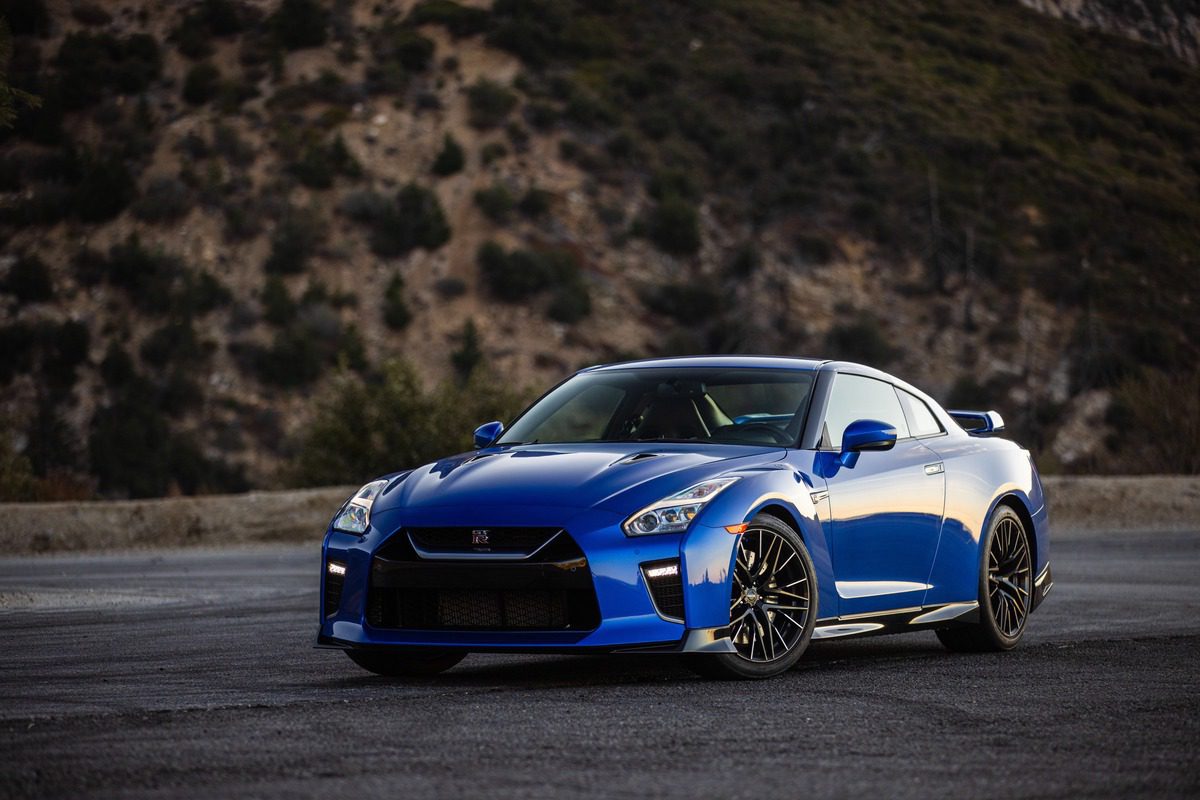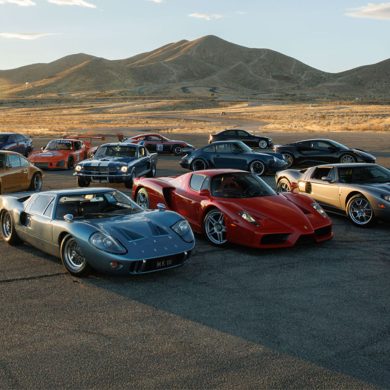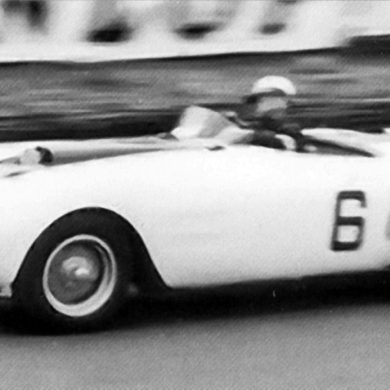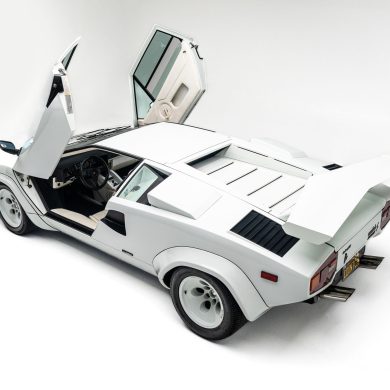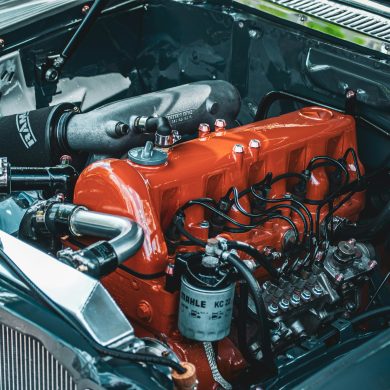When Jensen Interceptor got a Ferguson Formula all-wheel drive, it made the first step towards revolutionizing sports cars. The next milestone came with the Audi Quattro, and since then, all-wheel drive started its breakthrough to the mainstream. Gradually, sports cars of all shapes and sizes ended up adopting the layout—and today, seeing an all-wheel drive performance car is a common sight.
While it can’t be denied that all-wheel drive adds extra weight to cars, it also has benefits that outweigh this setback. When cars are pushed to their limits, extra torque on the front axle allows for more traction, making drivers feel more control over their automobiles.
In regular driving, having power on both axles also makes sports cars more dependable in suboptimal weather, making them enjoyable throughout the year. Thanks to all-wheel drive, these ten cars you can find on the market offer sublime performance and control in sun, rain and snow.
#1: Subaru WRX

An all-time all-season classic, the Subaru WRX STi has proven itself in every weather condition imaginable—both as a rally superstar and a roadgoing sports car. The secret behind Subaru’s unstoppable performance on all surfaces is its trademark symmetrical all-wheel drive combined with a boxer engine.
While the engine improves handling by having a lower center of gravity, the AWD system continuously sends power to all four wheels, redistributing torque to the opposite side should some of them lose traction. Subaru offers its sublime all-wheel drive as standard across the whole range, but its most famous application is definitely in the WRX range.
The all-new 2022 WRX has just hit the market, and with it, Subaru brought the sad news that it won’t make a STi variant based on it. So, while we’re waiting for what will quite possibly be an all-electric WRX STi sometime in the future, let’s see what the petrol-burning WRX has to offer.
The previous generation departed from the Impreza range, and for 2022, the gap between the two is even bigger—with the WRX now sporting a muscular look with an assertive design underlining its special place in Subaru’s lineup. As for the power, the WRX sports a 271-horsepower turbocharged 2.4-liter four-piston boxer with 6-speed manual.
In addition to symmetrical all-wheel drive, the WRX sports specially-tuned suspension to ensure optimal control regardless of road conditions. Add the starting price of $29,105 to the equation, and the WRX is once again guaranteed to offer a lot of bang for your buck.
#2: Porsche 911 Carrera 4 GTS

As long as the requirements match, it’s hard to imagine a list of sports cars without a Porsche 911 on it. From the 964 generation up to 2006, Porsche has been offering its quintessential sports car with PSK, an all-wheel drive system from the 959. From the 997 generation, Porsche started using PTM or Porsche Traction Management, a system originally built for the Cayenne SU.
Of course, PTM was thoroughly recalibrated for the 911, making the iconic car even more usable—helping their owners drive them throughout the year, even in conditions where rear-biased weight distribution would be more worrisome than fun. Since 2006, the 911 uses PTM or Porsche Traction Management, an active all-wheel drive system with electro-hydraulically controlled multi-plate clutch working in unison with other driving dynamic systems to distribute torque to the front wheels when necessary.
Today, Porsche offers the Carrera 4 in base, S and GTS trims, while PTM comes as standard in Turbo and Turbo S models as well. Our choice goes to the GTS variant for being the most sensible (yet still quite driver-focused) 911 you can drive during the whole year.
The 3.0-liter twin-turbocharged flat-six is good for 480 horsepower, and depending on your personal preference, it can be mated to 8-speed PDK automatic or a 7-speed manual. The GTS sports wider track, while Chrono Pack and lower ride height with adaptive dampers come as standard, underlining the car’s vigorous nature.
At $144,000 for the coupé, $149,500 for the convertible, or $156,800 for the Targa, the 911 4 GTS is not the cheapest ticket for an all-wheel drive Porsche experience, but it is the most balanced blend of engaging performance and daily usability.
#3: Nissan GT-R R35

The outgoing R35 Nissan GT-R was famous for its giant-killer reputation, courtesy of its state of the art twin-turbocharged 3.8-liter VR38DETT V6 and extremely capable all-wheel drive that gave it extra edge around the corners in all conditions. The ATTESA E-TS all-wheel drive is quite unique, as it features two carbon fiber driveshafts, with the main one sending torque to the 6-speed dual clutch rear transaxle and a limited slip differential.
By default, this system is strongly rear biased, with 98 percent of torque on the rear axle, making the GT-R act like a rear-wheel drive car in most driving situations. When complex electronics sense the need, the system diverts up to 50 percent of torque to the auxiliary drive shaft via a wet multi-plate clutch system. That way, the GT-R is under total control in all conditions—slippery roads included.
In its final form on the North American market, the GT-R comes in two guises. Starting at $113,540, the 565 horsepower GT-R Premium is a sensible choice (and the one you’ll find way more usable, considering its original purpose). For almost double the price though, the GT-R Nismo is a domesticated GT3 race car, sporting extensive use of carbon fiber panels, bespoke track-tuned suspension, Brembo carbon ceramic brakes, forged wheels, and a bump to 600 ponies.
While it’s highly unlikely that any of these will ever be daily driver cars, let alone in the colder parts of the year, the very idea that one can do it is downright amazing.
#4: Acura NSX Type S

If the mention of its name got you startled, we can’t really blame you—since the NSX flew under the radar for the better part of its production cycle. Introduced in 2016, the second generation NSX showcased Honda’s hybrid aspirations in the sports car segment, with the rear mid-mounted 3.5-liter V6 and a front Twin Motor Unit.
Needless to say, the NSX Sport Hybrid SH-AWD uses electric motors to independently send torque to each of the front wheels, while the internal combustion unit powers the rear wheels. This way, the NSX benefits during spirited driving, but what makes it weatherproof is how adjustable it is to one’s daily needs. When put in Quiet mode, the NSX can act like a regular commuter, whereas magnetorheological dampers respond accordingly too, offering a soothing ride for two occupants.
Limited to 350 examples worldwide, 300 out of which are in the United States, the Acura NSX Type S enjoyed numerous upgrades over the regular one—if there is any such thing as a “regular” NSX. The engineering team raised the combined power output from 573 to 602 horsepower through fitting the internal combustion engine with bigger GT3 Evo turbos and new fuel injectors, as well as recalibrating the Twin Motor Unit.
The emphasis was put on performance, so the NSX Type S boasts reprogrammed transmission, a retuned chassis and suspension, improved aerodynamics, and lighter forged wheels with Pirelli P-Zero semi slicks. Now, chances are, most of these instant classics will spend their life in garages, but that still doesn’t deny the fact that Acura built these cars to handle unforgiving weather with ease.
#5: Jaguar F-Type AWD

Smaller, sportier and more agile than any 2-door Jag we remember, this feline completely rebranded Jaguar’s sportiest segment, departing from opulent grand tourers into smaller, more agile and fiery sports cars. The F-Type came as just another refreshment that contributed to Jaguar’s rebirth as a modern company in the premium market, but a palette of spirited engines wasn’t the only trick Jag had up its sleeve.
Starting from 2016, the F-Type became available with optional all-wheel drive, and even though the move seemed blasphemous at the beginning, the idea of engaging the front axle turned out well. In the end, what cat uses only its hind legs, right?
For the starting price of $81,500, the AWD F-Type offers a supercharged 5.0-liter V8 with 444 horsepower on tap, while the $105,300 F-Type R with standard AWD will push the output up to 575 horsepower with a 0-60 sprint in 3.6 seconds and a top speed of 186 MPH.
The F-Type is one of the most exciting driver’s cars you can buy in this price range, and its all-wheel drive adds a layer of security without sacrificing much fun by only applying up to 30% of torque to the front wheels when needed.
#6: Audi RS6

Ever since the 1980s, Audi has been renowned for its rally-bred quattro all-wheel drive with a Torsen center differential distributing torque to both axles, providing stability and control in even the most unforgiving conditions. Now standard across the range, quattro was long an option on all but the range-topping models—the famous S and RS cars.
While the R8 could’ve been the obvious choice, our vote goes to the RS6 Avant, because it offers far greater daily usability (and it’s also the first RS longroof offered on the American market). As for the quattro, it’s electronically controlled and 40:60 rear biased, while maximum torque split is 85:15 front or rear, depending on the situation.
With a base price of $116,500, the RS6 sure does not come cheap, but a combination of its 591-horsepower 4.0-liter V8, lightning fast Tiptronic transmission, and RS-tuned adaptive air suspension more than makes up for the cost, offering both an unstoppable all-season mechanical force and a practical family hauler in one car.
#7: BMW G80 M3 Competition xDrive

Now that the public has gotten over the grille issue, the latest BMW M3 turned out to be pretty amazing, hitting all the right go-fast buttons out there. The press and the public unanimously concluded that it offered both sheer power, superb body control, precise steering—and above all, fun and a sense of engagement. For the 2022 model year, BMW brought an upgrade that introduced all-new dynamics to the M3 and M4 duo.
Available on the 503-horsepower Competition model only, xDrive adds power to the front axle for the first time in the M3 range. The xDrive system distributes power from the 3.0-liter twin-turbocharged straight six between the axles via an electronically-controlled multi-plate clutch.
The system is bespoke for the M3 and M4 and is rear-biased, continuously powering the rear axle and distributing torque to the front wheels when other electronic monitoring systems find it appropriate. That way, the traditional M Car experience is still present, but enhanced with minimal compromises.
#8: Bentley Continental GT Speed

The first Bentley released under Volkswagen’s ownership, the 2003 Continental GT brought a lot of refreshing alterations to the conservative brand. Most famously, the grand tourer got a 6.0-liter W12, Volkswagen Group’s idiosyncratic take on a compact high-performance engine. The W12 was originally mated to Torsen-based all-wheel drive, another novelty for the Crewe-based company.
From its introduction to this day, Bentley’s bestseller evolved, getting numerous improvements and performance-focused variants, one of which has actually held an official ice speed record since 2011. Piloted by Juha Kankunnen, the Bentley Continental GT Supersport achieved 205.48 MPH on the frozen Baltic Sea, proving how superlative its all-wheel drive system is in conjunction with the massive engine.
As of now, the Bentley Continental GT Speed is the most driver-oriented model in the range, sporting the latest evolution of the 6.0-liter W12 and active all-wheel drive to make full use of 650 horsepower and 664 lb-ft of torque. The torque is split equally, but up to 97% of it can be diverted to the rear wheels.
Truth be told, a small bump in horsepower and unchanged torque rating don’t sound like much on paper—but stiffer chassis, electronic limited slip differential, retuned suspension, and the introduction of rear-wheel steering all make the opulent grand tourer more drive-focused (and surprisingly lively for a 5,500 lb car). For those who can shell out at least $274,900, the Bentley Continental GT Speed is a plush grand tourer that can handle more gracefully than any of the numbers suggest.
#9: Lamborghini Huracán EVO

The first time Lamborghini equipped one of its sports cars with all-wheel drive was in the Diablo VT, which got a modified drivetrain from the LM002 Rambo Lambo, but the most widespread use was in the entry level sports car range, namely the Gallardo and its successor, the Huracán. Being related to the Audi R8, the Huracán shares its basic layout with the German supercar, but it’s fine-tuned for a sense of greater exclusivity.
A facelifted and upgraded Huracán EVO is one of the modern wedge wonders, offering way more than the social media clout it’s often associated with. When not going to the Moon, it makes full use of its 640-horsepower 5.2-liter TFSI V10 and 7-speed Doppia Frizione dual-clutch transmission.
The all-wheel drive system is managed by Lamborghini Integrated Vehicle Dynamics or LDVI the torque splits between the axles in 70:30 ratios, but an electronically-controlled multi-clutch system can send all torque to the rear wheels or split it up to 50:50 when necessary.
Thanks to its all-wheel drive system, the Huracán EVO is, in theory, a very forgiving and civilized car—but considering its price tag and aura it radiates, most of them will sadly only be driven around during the sunnier parts of the year.
#10: Toyota GR Corolla

Equipping hot hatchbacks with some form of all-wheel drive is truly nothing new, as many legends—starting from the Lancia Delta Integrale all the way to the Golf R and more recent 3rd generation Ford Focus RS—have all had it in some form. However, the latest pocket rocket with power on all four wheels is something truly special.
While most rear-biased all-wheel drive systems on this list are there to make sports cars livable during the seasons, the all-new GR Corolla has it with the sole purpose of blasting it around on all surfaces.
The GR Corolla was born from Toyota’s motorsport offensive and extensive know-how, which first gave us the GR Yaris. Just like its smaller stablemate, the GR Corolla is a true engineering masterclass showcasing the power of three: three hundred horsepower from a three-cylinder engine and three ways to split torque between the axles. Also, there are three exhausts, but that’s something we’ll just have to get used to.
Anyway, Gazoo Racing upped the turbocharged 1.6-liter 265-horsepower inline-three to 300 horsepower, again mating it mated to six-speed manual transmission, which distributes torque to both axles via GR-Four, a smart all-wheel drive system using two open differentials front and back and electronically controlled multi-clutch pack.
In Normal mode, the torque is split 60:40; Track mode gives it a 50:50 torque split, while Sport mode splits it 30:70. The base Core trim offers Torsen limited slip differentials as an option in the Performance package, while the more focused Circuit Edition will have them as standard (alongside a host of other upgrades, including a carbon fiber roof).
To sum it up, being a bigger, more practical and more powerful sibling of an actual WRC homologation special, the GR Corolla is most probably the ultimate all-season all-wheel drive sports car—and worry not, it will come to the States by the end of 2022.


